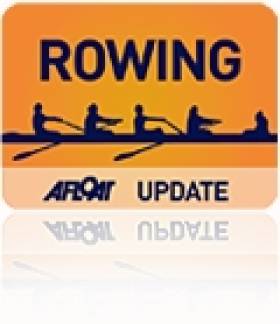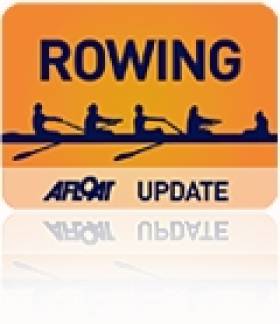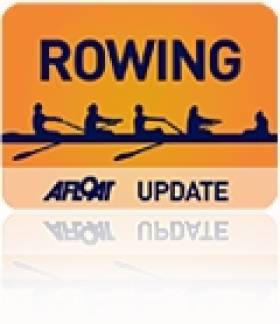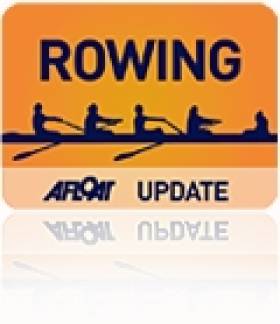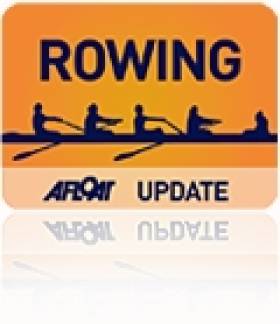Displaying items by tag: rowing
Ireland Miss Out on A Finals at World Under-23 Rowing
Ireland will not have an A Finalist at the World Under-23 Rowing Championships. Lisa Dilleen finished fifth in the semi-final of the women’s single scull and Sarah Dolan and Claire Lambe sixth in their semi-final of the lightweight double scull in Amsterdam this morning. They will compete in the B Final tomorrow. The two men's crews did not reach the A/B semi-finals.
World Under-23 Rowing Championships, Amsterdam - Day Four (Irish interest)
Women
Lightweight Double Scull – Semi-Final One (First Three to A Final; rest to B Final): 1 Greece 7:03.80, 2 Spain 7:05.59, 3 Netherlands 7:06.49; 4 Romania 7:12.98, 5 Austria 7:14.20, 6 Ireland (S Dolan, C Lambe) 7:14.86.
Single Scull – Semi-Final One (First Three to A Final; rest to B Final); 1 Serbia (I Filipovic) 7:36.42, 2 Estonia (K Pajusalu) 7:36.89, 3 Azerbaijan (I Angelova) 7:36.94; 4 Ukraine 7:38.55, 5 Ireland (L Dilleen) 7:43.02, 6 Denmark 8:14.00.
Quadruple Misses Out on Semi-Final in Amsterdam
Ireland’s men’s lightweight quadruple scull failed to join the two women’s crews in the semi-finals of the World Under-23 Rowing Championships in Amsterdam. The crew of Shane O’Driscoll, Niall Kenny, Peter Hanily and Justin Ryan could only finish fifth in their repechage, where the top three qualified. Denmark and Switzerland headed the field, with Poland finishing well to take third. Britain were fourth and are set for the B Final alongside Ireland.
Lightweight single sculler Jonathan Mitchell finished third in his C/D semi-final and qualified for the C Final (places 13 to 18).
World Under-23 Rowing Championships, Day Three (Irish interest)
Men
Lightweight Quadruple Scull – Repechage Two (First Three to A/B Semi-Finals; rest to B Final): 1 Denmark 5:54.81, 2 Switzerland 5:56.16, 3 Poland 5:57.97; 4 Britain 6:00.23, 5 Ireland (S O’Driscoll, N Kenny, P Hanily, J Ryan) 6:04.17, 6 Austria 6:08.25.
Lightweight Single Scull – Quarter Final Four: 1 United States (A Campbell Jr) 7:11.51, 2 Greece (P Magdanis) 7:14.64, 3 Peru (R Leon Garcia) 7:20.45; 4 Ireland (J Mitchell) 7:33.62, 5 Iraq 7:40.79, 6 Armenia 8:00.14. C/D Semi-Final (First Three to C Final): 1 Chile 7:18.31, 2 Sweden 7:19.38, 3 Ireland (Mitchell) 7:19.99.
Women
Lightweight Double Scull – Repechage (First Three to A/B Semi-Finals): 1 Ireland (S Dolan, C Lambe) 7:24.04, 2 Romania 7:24.63, 3 Italy 7:26.92; 4 Czech Republic 7:35.46, 5 Tunisia 8:00.09.
Single Scull – Repechage (First Three to A/B Semi-Finals): 1 The Netherlands (N Beukers) 7:45.46, 2 Ireland (L Dilleen) 7:45.81, 3 Greece (A Nikolaidou) 7:52.71; 4 Latvia 8:06.32, 5 USA 8:11.64.
Irish Women Power into World Under-23 Rowing Semi-Finals
Ireland’s two women’s boats, the lightweight double scull and the single scull, will both compete in the semi-finals at the World Under-23 Rowing Championships in Amsterdam after good results in repechages today.
Claire Lambe and Sarah Dolan passed three boats to win an exciting repechage of the lightweight double scull. Ireland were in fourth place, outside a qualification spot for the semi-finals, coming up to half way, but they made a powerful move around 1250 metres, and they swept past Italy and the Czech Republic over the next few hundred metres. In the closing stages they then passed Romania to win.
Lisa Dileen finished second in the repechage of the single scull. She was in a comfortable second place at 1500 metres, but actually passed Nicole Beukers of the Netherlands to lead in the closing stages, before the home favourite battled back to win by .35 of a second.
World Under-23 Rowing Championships, Day Three (Irish interest)
Men
Lightweight Single Scull – Quarter Final Four: 1 United States (A Campbell Jr) 7:11.51, 2 Greece (P Magdanis) 7:14.64, 3 Peru (R Leon Garcia) 7:20.45; 4 Ireland (J Mitchell) 7:33.62, 5 Iraq 7:40.79, 6 Armenia 8:00.14.
Women
Lightweight Double Scull – Repechage (First Three to A/B Semi-Finals): 1 Ireland (S Dolan, C Lambe) 7:24.04, 2 Romania 7:24.63, 3 Italy 7:26.92; 4 Czech Republic 7:35.46, 5 Tunisia 8:00.09.
Single Scull – Repechage (First Three to A/B Semi-Finals): 1 The Netherlands (N Beukers) 7:45.46, 2 Ireland (L Dilleen) 7:45.81, 3 Greece (A Nikolaidou) 7:52.71; 4 Latvia 8:06.32, 5 USA 8:11.64.
Mitchell Finishes Fourth in World Rowing Quarter-Finals
Ireland’s Jonathan Mitchell missed out on a place in the A/B semi-finals after a fourth-place finish in the quarter-finals of the lightweight single scull at the World Under-23 Championships in Amsterdam. The Queen’s University man needed to finish in one of the first three positions, but the United States, Greece and Peru had firmly established themselves in a stretched-out 1-2-3 formation by halfway, with Mitchell further back in fourth. It stayed this way to the finish.
World Under-23 Rowing Championships, Day Three (Irish interest)
Men
Lightweight Single Scull – Quarter Final Four (First Three to A/B Semi-Finals): 1 United States (A Campbell Jr) 7:11.51, 2 Greece (P Magdanis) 7:14.64, 3 Peru (R Leon Garcia) 7:20.45; 4 Ireland (J Mitchell) 7:33.62, 5 Iraq 7:40.79, 6 Armenia 8:00.14.
Dilleen Defers Crucial Battle at World Under-23 Rowing
Ireland’s Lisa Dilleen finished fourth in her heat of the women’s single scull at the World Under-23 Rowing Championships in Amsterdam today and must compete in a repechage to make the semi-finals. The race had a surprising profile; with two crews to qualify, the Galway woman and Natliya Dovgodko of the Ukraine looked sensible in shadowing world under-23 champion Donata Vistartaite of Lithuania. However, Iskra Angelova of Azerbaijan sprinted into an early lead, and stayed out in front to the end. Vistartaite challenged her but then settled for second. Dovgodko expended energy testing Vistartaite near the finish but ended in third, while Dilleen settled for fourth and a second chance tomorrow.
World Under-23 Rowing Championships, Amsterdam, Day Two (Irish interest):
Men
Lightweight Single Scull – Heat Six (First Three to Quarter-Finals): 1 Germany (R Acht) 7:47.10, 2 Sweden (O Russberg) 7:53.46, 3 Ireland (J Mitchell) 7:59.95; 4 Chile 8:03.41
Women
Lightweight Double Scull – Heat Two (First Three Directly to A/B Semi-Finals; rest to repechage): 1 Germany 7:34.87, 2 Austria 7:36.35, 3 Canada 7:38.95; 4 Ireland (S Dolan, C Lambe) 7:40.72, 5 Tunisia 8:32.32.
Single Scull – Heat One (First Two Directly to A/B Semi-Finals; rest to repechage): 1 Azerbaijan (I Angelova) 8:08.90, 2 Lithuania (D Vistartaite) 8:10.42; 3 Ukraine 8:12.24, 4 Ireland (L Dilleen) 8:21.09, 5 Netherlands 8:26.54, 6 Denmark 8:41.31.
Queen's Man in World Rowing Quarter-Finals
Jonathan Mitchell qualified for the quarter-finals of the lightweight single scull at the World Under-23 Championships in Amsterdam. The Queen’s University man finished third in his heat, behind Germany and Sweden.
World Under-23 Rowing Championships, Amsterdam, Day Two (Irish interest):
Men
Lightweight Single Scull – Heat Six (First Three to Quarter-Finals): 1 Germany (R Acht) 7:47.10, 2 Sweden (O Russberg) 7:53.46, 3 Ireland (J Mitchell) 7:59.95; 4 Chile 8:03.41
Quadruple Gives Ireland Under-23 Rowing Team Fine Start
Ireland’s lightweight men’s quadruple got the team off to a great start at the World Under-23 Championships in Amsterdam when they qualified directly for the semi-finals. With three boats to qualify, Italy pinned down their place with a clear win, but Ireland took a good second place, holding off France, who also qualified. Britain finished fourth and must find their way to the last 12 through a repechage.
World Under-23 Rowing Championships, Amsterdam (Irish interest)
Men, Lightweight Quadruple Scull – Heat Two (First Three Directly to A/B Semi-Finals): 1 Italy 5:53.39, 2 Ireland 5:56.25, 3 France 5:57.18; 4 Britain 6:01.65, 5 Serbia 6:29.55.
UCD Win Big Pot at National Rowing Championships
UCD are the new Irish men’s senior eights champions. In extremely difficult conditions at the National Rowing Championships in Cork, the big crew saw off an early challenge by Queen’s University and a late charge by NUIG/Grainne Mhaol to win their first Big Pot in 38 years.
The UCD women’s senior eight completed a great day for the college when they beat Muckross in their final.
National Rowing Championships, National Rowing Centre, Cork - Day Three
Men
Eight – Senior: 1 UCD (S Craven, P Grogan, D Pierce, D Neale, F Manning, S Jacob, G Duane, T Doyle; cox: J Lynch) 5:39.5, 2 NUIG/Grainne Mhaol 5:41.8, 3 Queen’s University 5:44.2, 4 Trinity 6:08.7.
Four – Novice, coxed: 1 NUIG, 2 Cappoquin, 3 UCC.
Pair – Intermediate: 1 Queen’s University (A Little, K Duffy) 6:58.4, 2 NUIG 8:03.9, 3 Carlow 7:01.1. Junior 18A: 1 Bann 6:53.2, 2 St Joseph’s College 6:57.1, 3 Presentation College 7:06.9.
Sculling, Quadruple – Junior 18A: 1 Castleconnell 6:06.2, 2 Skibbereen 6:12.0, 3 Offaly 6:12.8. Junior 16, coxed (non-Championship): 1 Galway 6:45.4, 2 Tribesmen 6:48.0, 3 Cork 6:51.8
Double – Intermediate: 1 Carlow 6:40.5, 2 Skibbereen 6:41.0, 3 Queen’s 6:55.0.
Single – Senior: 1 Muckross (S Casey) 6:56.0, 2 Skibbereen A (P O’Donovan) 6:56.5, 3 Muckross (C Moynihan) 7:20.8, 4 Skibbereen (Murphy) 7:28.3, 5 Skibbereen (McCarthy) 7:37.0. Lee Valley (Keohane) did not start.
Women
Eight – Senior: 1 UCD (C Tanner, K Joy, C Ni Reachtagain, N Fearon, S Bennett, L Gannon, L Reid, A Gilligan; cox: E Craven) 6:29.9, 2 Muckross 6:34.1, 3 St Michael’s 6:38.6, 4 NUIG 6:40.5, 5 Queen’s 6:42.2, 6 Trinity 7:07.8.
Intermediate: 1 Queen’s University 6:33.8, 2 Trinity 6:41.1, 3 St Michael’s 6:44.2. Novice: 1 Galway 6:42.6, 2 Queen’s 6:50.2, 3 Carrick-on-Shannon 7:01.5. Junior 16 (non-Championship): 1 Galway 6:49.2, 2 Cork 6:59.6, 3 Portora 7:09.0.
Pair – Junior 18: 1 St Michael’s 7:43.9, 2 Portora 7:52.4, 3 Commercial 8:41.3.
Sculling, Quadruple – Novice: 1 Commercial 7:56.3, 2 Neptune 8:06.0, 3 Clonmel 8:11.9. Junior 18A: 1 Skibbereen 6:58.7, 2 Cork 7:05.5, 3 Neptune 7:13.5.
Single – Senior: 1 City of Derry (L D’Urso) 7:56.5, 2 Three Castles (E Moran) 8:10.9, 3 Portora (H Nixon) 8:20.4, 4 Three Castles (Quinn) 8:28.6, 5 Old Collegians (Walshe) 9:08.7. Killorglin (M Dukarska) did not finish. Intermediate: 1 City of Derry (L D’Urso), 2 Skibbereen (Walsh), 3 Shandon (Corcoran-O’Hare).
Dukarska's Spectacular Capsize Robs Her of Title
Windy conditions and choppy water played their part in three capsizes in the first session of finals at the National Rowing Championships at the National Rowing Centre in Cork. By far the most important befell Monika Dukarska, who was leading just metres short of the line in the women’s senior single sculls when she missed a stroke and fell in. Laura D’Urso capitalised to take the title.
Sean Casey took the men’s senior sculls title after a fine race down the choppy course with Paul O’Donovan. Queen’s won the women’s intermediate eight and the men’s intermediate pair – in which Trinity (before the race) and Carlow (at the end of it) both capsized.
National Rowing Championships, National Rowing Centre, Cork - Day Three
Men
Pair – Intermediate: 1 Queen’s University (A Little, K Duffy) 6:58.4, 2 NUIG 8:03.9, 3 Carlow 7:01.1.
Sculling, Quadruple – Junior 18A: 1 Castleconnell 6:06.2, 2 Skibbereen 6:12.0, 3 Offaly 6:12.8.
Single – Senior: 1 Muckross (S Casey) 6:56.0, 2 Skibbereen A (P O’Donovan) 6:56.5, 3 Muckross (C Moynihan) 7:20.8, 4 Skibbereen (Murphy) 7:28.3, 5 Skibbereen (McCarthy) 7:37.0. Lee Valley (Keohane) did not start.
Women
Eight – Intermediate: 1 Queen’s University 6:33.8, 2 Trinity 6:41.1, 3 St Michael’s 6:44.2. Novice: 1 Galway 6:42.6, 2 Queen’s 6:50.2, 3 Carrick-on-Shannon 7:01.5.
Pair – Junior 18: 1 St Michael’s 7:43.9, 2 Portora 7:52.4, 3 Commercial 8:41.3.
Sculling, Quadruple – Novice: 1 Commercial 7:56.3, 2 Neptune 8:06.0, 3 Clonmel 8:11.9.
Single – Senior: 1 City of Derry (L D’Urso) 7:56.5, 2 Three Castles (E Moran) 8:10.9, 3 Portora (H Nixon) 8:20.4, 4 Three Castles (Quinn) 8:28.6, 5 Old Collegians (Walshe) 9:08.7. Killorglin (M Dukarska) did not finish.
Skibbereen Keep the Heat On at National Rowing Championships
Skibbereen brought their titles up to five for the first two days of the National Rowing Championships in Cork by taking the women’s senior pair through Christine Fitzerald and Denise Walsh and combining with Lee Valley to win the men’s senior quadruple scull. The women’s Junior 18A eight was an emphatic win for St Michael’s, and Sarah Allen of Bann, who is just 16, was also in commanding form as she won the women’s novice single sculls championship.
The main action of the day ended with Anthony English of UCD taking the men’s intermediate single scull and Castleconnell’s Dylan Quigley and Adrian Sheahan taking the men’s junior 18A double scull.
National Rowing Championships, National Rowing Centre, Cork – Day Two
Men
Eight – Intermediate: 1 Queen’s 6:00.1, 2 Trinity 6:01.7, 3 Neptune 6:05.5.
Four, coxed – Junior 18A: 1 Bann 6:33.5, 2 St Joseph’s College 6:41.8, 3 Portora 6:47.6. Masters, coxed (non-Championship): 1 Commercial/City of Derry, 2 Fermoy, 3 Galway RC.
Pair – Senior: 1 Queen’s (E Mac Domhnaill, M Ewing) 6:56.7, 2 Grainne Mhaol 7:01.1, 3 St Michael’s 7:01.7, 4 Queen’s B 7:12.9, 5 Galway B 7:15.0, 6 Galway A 7:52.7.
Sculling, Quadruple – Senior: 1 Skibbereen/Lee Valley (G O’Donovan, G Murphy, K McCarthy, C Dowling) 6:05.1, 2 Queen’s 6:07.2, 3 University of Limerick/Garda 6:09.7.
Double – Junior: 1 Castleconnell (D Quigley, A Sheahan) 6:37.4, 2 Lee 6:44.2, 3 Commercial 6:45.7.
Single – Intermediate: 1 UCD (A English) 7:17.8, 2 Skibbereen 7:27.9, 3 Neptune 7:31.0. Junior 16 (non-Championship): 1 Cork (D Buckley) 7:38.1, 2 Offaly (Phelan) 7:38.6, 3 Cork 7:50.4.
Women
Eight – Junior 18A: 1 St Michael’s 6:49.3, 2 Cork 7:00.3, 3 Portora 7:03.6.
Pair – Senior: 1 Skibbereen (C Fitzgerald, D Walsh) 7:53.0, 2 Commercial 8:02.8, 3 St Michael’s 8:03.6.
Sculling, Quadruple – Senior: 1 Skibbereen 6:51.2, 2 Old Collegians/Three Castles 6:51.7, 3 St Michael’s 7:14.5. Junior 16 (non-Championship): 1 Galway 7:27.1, 2 Commercial 7:39.1, 3 Muckross 7:49.3.
Double – Intermediate: 1 Commercial 7:35.1, 2 Skibbereen 7:40.0, 3 Garda 8:17.0.
Single – Novice: 1 Bann (S Allen) 8:43.2, 2 Shandon (R Mertz) 8:47.9, 3 Queen’s (H Adley) 8:50.7. Junior 18A: 1 Fermoy (H Shinnick) 8:05.9, 2 Skibbereen (M Dineen) 8:10.7, 3 Portora (K Cromie) 8:19.7.


























